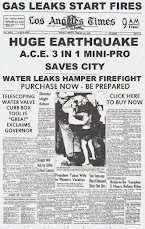Structure fire - high-rise building tools
Outfitting Firefighters
Meet Tom Carroll (left) and Ed Fales. Tom is a lieutenant and Ed is a firefighter and paramedic with Engine Company 1 in Cambridge, Massachusetts.
You will see how Tom and Ed would suit up in response to a fire in a high-rise building and what assorted tools they would carry. By the time they are fully equipped, each of them will be carrying a staggering load of state-of-the-art gear weighing between 80 and 100 pounds and costing almost $4,500 per man.
| | Two-way radio | |
| | Leather boots and rubber boots Rubber boots (worn by Ed) have strong pull loops at the top of the boot, allowing firefighters to quickly pull them on. They have a heavy felt lining for comfort and protection, steel toes, and slip-resistant soles. When firefighters are at their station they keep the shank of their boots inside the cuff of their turnout pants and position them next to the fire trucks so they can don their boots and pants in one swift motion when responding to a call. | |
| | Turnout pants | |
| | Hood | |
| | Helmet | |
| | Turnout coat | |
| | SCBA tank and SCBA mask The SCBA is similar to the SCUBA gear used by divers, but instead of delivering air on demand as with underwater breathing devices, the SCBA offers a constantly flowing stream of air (a so-called "open circuit") through the firefighter's face mask so he or she does not have to inhale to initiate airflow. Depending on the nature of the fire, a firefighter will carry a tank that holds between 30 minutes and one hour of air. | |
| | PASS motion alarm | |
| | Flashlight | |
| | Gloves | |
| | Rabbit tool | |
| | Rake | |
| | Irons | |
| | Fire extinguisher | |
| | Hose | |
| | Thermal-imaging camera The camera works by imaging the levels of heat in a room, from very dark (coolest) to very light (hottest). A firefighter searching for a victim in a fire would look for dark areas; when searching for a hot spot behind a wall, he would look for light areas. | |
| | Safety Line |
Two-way radio | Boots | Turnout pants | Anti-flash hood | Helmet | Turnout coat | SCBA | PASS motion alarm | Flashlight | Gloves | Rabbit tool | Rake | Irons | Fire extinguisher | Hose | Thermal imaging camera | Safety line





